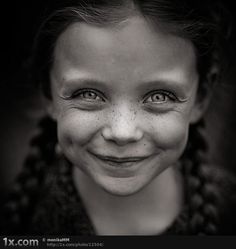I don't look at people's faces for very long, only enough to gauge their 'on the surface' moods. So, often I miss the difference between a genuine smile and a fake one. If I really want to know, I will look intently for a real smile. The sort that a child has, before society enacts it's toll on the individual.
=================================================
Ever noticed how there are basically two types of smiles: a genuine smile and a fake one?
This distinction has been of interest to researchers for quite sometime now. In fact, the genuine smile has a name. It's called the "Duchenne smile," named after the French physician Guillaume Duchenne, who studied the physiology of facial expressions in the nineteenth century.
The Duchenne smile involves both voluntary and involuntary contraction from two muscles: the zygomatic major (raising the corners of the mouth) and the orbicularis oculi (raising the cheeks and producing crow's feet around the eyes).
A fake smile or, as I like to call it, a "Say Cheese" smile involves the contraction of just the zygomatic major since we cannot voluntarily contract the orbicularis oculi muscle.
Scientists have discovered that these two types of smiles are actually controlled by two completely different parts of our brain.
When a patient with damage to the motor cortex on the brain's left hemisphere attempts to smile, the smile is asymmetrical, with the right side of the smile not moving as it should. However, when that same patient spontaneously laughs, the smile is normal with no asymmetry. This means that the genuine smile is controlled by some other part of the brain.
Now, when a patient with damage to the anterior cingulate (part of the limbic system) in the left hemisphere attempts to smile, there is no asymmetry. The smile is normal. However, when that same patient tries to smile spontaneously, the asymmetry appears.
Thus, the Say Cheese smile is controlled by the motor cortex while emotion-related movements, like the Duchenne smile, is controlled by the limbic system (the emotional center of the brain).
https://www.psychologytoday.com/ca/...-science-has-say-about-genuine-vs-fake-smiles
Video vaguely related to the article:
https://petapixel.com/2014/09/14/can-spot-fake-smile-photograph/
How are you personally at deciding whether a smile is genuine or false?
=================================================
Ever noticed how there are basically two types of smiles: a genuine smile and a fake one?
This distinction has been of interest to researchers for quite sometime now. In fact, the genuine smile has a name. It's called the "Duchenne smile," named after the French physician Guillaume Duchenne, who studied the physiology of facial expressions in the nineteenth century.
The Duchenne smile involves both voluntary and involuntary contraction from two muscles: the zygomatic major (raising the corners of the mouth) and the orbicularis oculi (raising the cheeks and producing crow's feet around the eyes).
A fake smile or, as I like to call it, a "Say Cheese" smile involves the contraction of just the zygomatic major since we cannot voluntarily contract the orbicularis oculi muscle.
Scientists have discovered that these two types of smiles are actually controlled by two completely different parts of our brain.
When a patient with damage to the motor cortex on the brain's left hemisphere attempts to smile, the smile is asymmetrical, with the right side of the smile not moving as it should. However, when that same patient spontaneously laughs, the smile is normal with no asymmetry. This means that the genuine smile is controlled by some other part of the brain.
Now, when a patient with damage to the anterior cingulate (part of the limbic system) in the left hemisphere attempts to smile, there is no asymmetry. The smile is normal. However, when that same patient tries to smile spontaneously, the asymmetry appears.
Thus, the Say Cheese smile is controlled by the motor cortex while emotion-related movements, like the Duchenne smile, is controlled by the limbic system (the emotional center of the brain).
https://www.psychologytoday.com/ca/...-science-has-say-about-genuine-vs-fake-smiles
Video vaguely related to the article:
https://petapixel.com/2014/09/14/can-spot-fake-smile-photograph/
How are you personally at deciding whether a smile is genuine or false?
Last edited:


